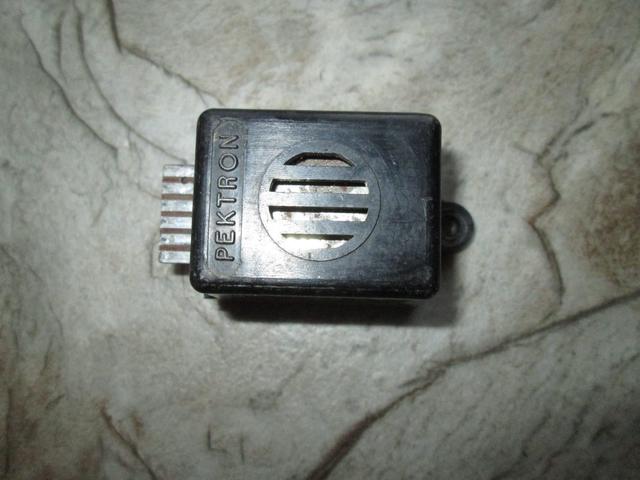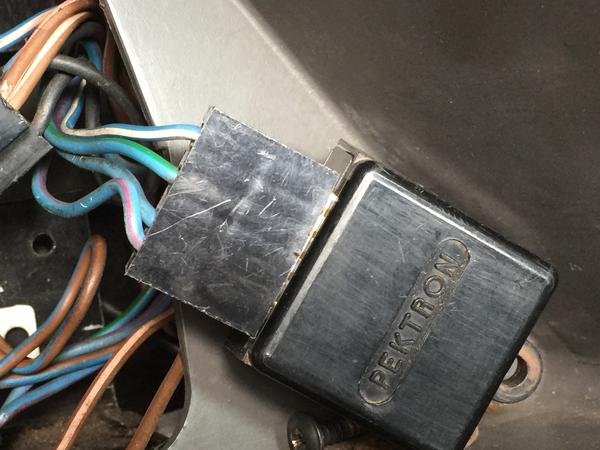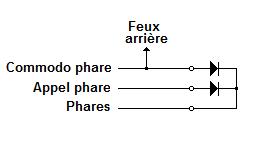je cherche ma panne de warning et appel de phare et je suis tombé sur ça :


cékoidonc ?
Merci !



Je connais comme redresseur... mais pas plus...TECKTRON

violet, noir, rouge/ blanc, ok.. + jaune/violet + jaune/ marron+ vert/vert/violet?côté câble il y a du violet, noir, rouge et blanc, jaune et vert de mémoire.


Je corrige ... c'est PEKTRON ...Pat67 a écrit :Je connais comme redresseur... mais pas plus...TECKTRON
 Album MG
Album MG Album MG
Album MGDans ma mémoire, ce qu'il en reste, l'intonation y était...Je corrige ... c'est PEKTRON ...

Ben... rien : suffit d'envoyer du 12V sur le + des phares ou du relais (et le faire arriver...) : le commodo gauche le fait très bien ...Quel type de boitier je dois acheter pour faire fonctionner mes appels de phare ?
...et en plus j’ai confondu avec "semikron"… la tête…Pat67 a écrit :Dans ma mémoire, ce qu'il en reste, l'intonation y était...Je corrige ... c'est PEKTRON ...... et PEKTRON ensemble... ça changera l'air...
JMAU a écrit :Je sais où chercher...Ben... rien : suffit d'envoyer du 12V sur le + des phares ou du relais (et le faire arriver...) : le commodo gauche le fait très bien ...Quel type de boitier je dois acheter pour faire fonctionner mes appels de phare ?
(+) >> fil violet >> commodo gauche en tirant vers soi >> fil bleu/blanc >> (Relais) // phare >> fil noir >> masse.

Je pense que cette prise Pektron qui doit ( selon les couleurs des fils?) être branchée sur le système d'alarme des ceintures de sécurité n'est pas la bonne...mais vu que j'ai cette prise il va falloir que je la supprime..
Peut-être pas, j’ai déjà vu ça quelque part… juste pour éviter d’allumer les feux arrière en appel de phares… je vérifierai quand même si cela n’a pas un lien…Mon problème d'appel de phare vient d'ailleurs.
 Album MG
Album MGNe pas taper...ça risque pas...
Ou peut-être que l’appel des phares est sur un circuit avant le contact, alors que le commodo lui est sur un circuit après le contact… il est évident que si le contact est coupé et que le commodo est sur la position phares, un appel de phares alimentera le commodo donc tout le réseau après le contact… ce ne sont que des suppositions mais qui restent logiques…je vérifierai quand même si cela n’a pas un lien…
Ou simplement, c'est un relais... plat...je cherche ma panne de warning et appel de phare et je suis tombé sur ça :
Saby, à lire vos anciens messages, je trouve que vous avez vieilli bien jeune… il serait temps de sortir de dessous de votre bgt et d’aller voir autre chose… le monde bouge...ça risque pas...
:-)

On va arranger ça:bon je suis plus que mauvais en électricité...
!
/bin/bash
######
# Author: Steven Shiau <steven _at_ clonezilla org>, Ceasar Sun <ceasar _at_ clonezilla org>
# License: GPL
# Description: Program to make USB flash drive (FAT, EXT, BTRFS , XFS or NTFS) bootable by syslinux or extlinux
# Main steps:
# 1. Checking if partition table correct (on boundary, bootable)
# 2. cat mbr
# 3. Run "syslinux -f -i" or "extlinux -i"
#
# Update history:
# 2016/3/7 by Ceasar
# 1. Fix: use "findmnt" to get mount path
# 2. Fix: consider mount path with "space" character ex: "/media/user/USB\ DISK"
# 2016/8/27 by David Tonhofer
# 1. Rewrite some codes to reuse.
# 2. Add comments.
######
set -u
# Append PATH
export PATH=/sbin:/usr/sbin:/bin:/usr/bin:$PATH
# Settings
ocs_batch_mode="false"
#
prog="$(basename $0)"
path_of_prog="$(LC_ALL=C cd "$(dirname "$0")/../../"; pwd)"
#
[ -z ${SETCOLOR_SUCCESS:-''} ] && SETCOLOR_SUCCESS="echo -en \\033[1;32m"
[ -z ${SETCOLOR_FAILURE:-''} ] && SETCOLOR_FAILURE="echo -en \\033[1;31m"
[ -z ${SETCOLOR_WARNING:-''} ] && SETCOLOR_WARNING="echo -en \\033[1;33m"
[ -z ${SETCOLOR_NORMAL:-''} ] && SETCOLOR_NORMAL="echo -en \\033[0;39m"
BOOTUP="color"
#
msg_are_u_sure_u_want_to_continue='Are you sure you want to continue?'
msg_you_have_to_enter_yes_or_no="You have to enter 'y', 'yes', 'n' or 'no'. Please enter it again!"
msg_do_you_want_to_make_it_bootable="Do you want to mark it as bootable ?"
#
USAGE() {
echo "$prog - To make the device bootable with syslinux/extlinux"
echo "Usage: $prog [OPTION] partition_device_holding_clonezilla_filetree"
echo "Options:"
echo "-b, --batch-mode batch, unattended mode. Use carefully! DANGEROUS!!!"
echo "-L, --LABEL STRING set device via LABEL if LABEL exists"
echo "-U, --UUID STRING set device via UUID"
echo "This script is assumed to ACTUALLY RESIDE IN THE CORRECT PLACE OF THE CLONEZILLA FILE TREE!"
echo "The path to it is used to find other files!"
echo "Note:"
echo " Device assignment priority: Partition name > UUID > LABEL (if not only one NAME-TYPE is assigned)"
echo "Ex:"
echo "To make \"/dev/sdg1\" bootable on GNU/Linux:"
echo " $prog /dev/sdg1"
echo "To make device label \"LABEL_STRING\" bootable on GNU/Linux:"
echo " $prog -L LABEL_STRING"
echo "To make device with UUID \"UUID_STRING\" bootable on GNU/Linux:"
echo " $prog -U UUID_STRING"
}
# Check if root or not
check_if_root() {
if [ ! "$UID" = "0" ]; then
echo
echo "[$LOGNAME] You need to run this script \"`basename $0`\" as root."
echo
exit 1
fi
}
#
to_continue_or_not() {
local prompt_msg="$1"
continue_choice=""
while [ -z "$continue_choice" ]; do
[ "$BOOTUP" = "color" ] && $SETCOLOR_WARNING
echo "$prompt_msg"
[ "$BOOTUP" = "color" ] && $SETCOLOR_NORMAL
echo -n "[y/n] "
read continue_choice
case "$continue_choice" in
y|Y|[yY][eE][sS])
echo "OK! Let's do it!" ;;
n|N|[nN][oO])
echo "Program terminated!"
exit 1
;;
*)
[ "$BOOTUP" = "color" ] && $SETCOLOR_WARNING
echo "$msg_you_have_to_enter_yes_or_no!"
[ "$BOOTUP" = "color" ] && $SETCOLOR_NORMAL
echo "--------------------------------------------"
;;
esac
done
} # end of to_continue_or_not
#
get_diskname() {
local disk=${1#/dev/*}
if [ -n "$disk" ]; then
echo "$disk" | sed -e 's/^\([^0-9]*\)[0-9]*$/\1/g' \
-e 's/^\(.*[0-9]\{1,\}\)p[0-9]\{1,\}$/\1/g'
fi
} # end of get_diskname
#
get_part_number() {
local disk=${1#/dev/*}
local num=""
if [ -n "$disk" ]; then
num=$(echo "$disk" | sed -e 's/^[^0-9]*\([0-9]*\)$/\1/g' \
-e 's/^.*[0-9]\{1,\}\(p[0-9]\{1,\}\)$/\1/g')
fi
echo $num
} # end of get_part_number
#
check_if_syslinux_runs() {
local sys_exec="$1"
local lrc
# Check if the libc6-i386 (debian/ubuntu) files exists, which is required
# for running 32-bit syslinux
# E.g. On Debian AMD64 system without installing libc6-i386,
# $ ldd syslinux
# not a dynamic executable
# If libc6-i386 is installed:
# $ ldd syslinux
# linux-gate.so.1 => (0xf77dd000)
# libc.so.6 => /lib32/libc.so.6 (0xf7661000)
# /lib/ld-linux.so.2 (0xf77e0000)
# It's easier we use "syslinux -h" to test if it runs:
# $ ls -alFh ./syslinux
# -rwxrwxr-x 1 steven steven 209K Oct 7 00:32 ./syslinux*
# $ ./syslinux -h
# bash: ./syslinux: No such file or directory
# $ echo $?
# 127
# The above is the case which libc6-i386 is not installed, and the
# return code is 127.
if [ -z "$sys_exec" ]; then
[ "$BOOTUP" = "color" ] && $SETCOLOR_FAILURE
echo "Variable sys_exec was not assigned!"
[ "$BOOTUP" = "color" ] && $SETCOLOR_NORMAL
echo "Program terminated!"
exit 1
fi
if [ ! -e "$sys_exec" ]; then
[ "$BOOTUP" = "color" ] && $SETCOLOR_FAILURE
echo "File \"$sys_exec\" does not exist!"
[ "$BOOTUP" = "color" ] && $SETCOLOR_NORMAL
echo "Program terminated!"
exit 1
fi
$sys_exec -h 2>/dev/null >/dev/null
lrc=$?
if [ "$lrc" -ne 0 ]; then
if [ "$(LC_ALL=C uname -m)" = "x86_64" ]; then
[ "$BOOTUP" = "color" ] && $SETCOLOR_FAILURE
echo "On x86-64 system, you should install libc6-i386 (for Debian/Ubuntu) or glibc.i686 (for Fedora/CentOS/OpenSuSE) package so that the required libraries to run 32-bit program $sys_exec exist."
[ "$BOOTUP" = "color" ] && $SETCOLOR_NORMAL
echo "Program terminated!"
exit 1
fi
fi
return $lrc
} # end of check_if_syslinux_runs
#
export LANG=C
target_part_label=''
target_part_uuid=''
#
while [ $# -gt 0 ]; do
case "$1" in
-b|--batch) ocs_batch_mode="true"; shift;;
-L|--LABEL) shift
if [ -z "$(echo $1 |grep ^-.)" ]; then
# only accept argument if it doesn't look like an option
target_part_label=$1
shift;
fi
[ -z "$target_part_label" ] && USAGE && exit 1
;;
-U|--UUID) shift
if [ -z "$(echo $1 |grep ^-.)" ]; then
# only accept argument if it doesn't look like an option
target_part_uuid=$1
shift;
fi
[ -z "$target_part_uuid" ] && USAGE && exit 1
;;
-*) echo "${0}: ${1}: invalid option" >&2
USAGE >& 2
exit 2 ;;
*) break ;;
esac
done
#
check_if_root
target_part="$1"
if ! type parted &>/dev/null; then
[ "$BOOTUP" = "color" ] && $SETCOLOR_FAILURE
echo 'Program "parted" was not found on this GNU/Linux system. Please install it.'
[ "$BOOTUP" = "color" ] && $SETCOLOR_NORMAL
echo "Program terminated!"
exit 1
fi
if ! type blkid &>/dev/null; then
[ "$BOOTUP" = "color" ] && $SETCOLOR_FAILURE
echo 'Program "blkid" was not found on this GNU/Linux system. Please install it.'
[ "$BOOTUP" = "color" ] && $SETCOLOR_NORMAL
echo "Program terminated!"
exit 1
fi
if [ -n "$target_part_label" -a -z "$target_part" ] ; then
target_part_via_label="$(LC_ALL=C blkid | grep -iE "^/dev/[hsu][bd][a-z]+[[:digit:]]+.+LABEL=\"$target_part_label\".*" | grep -oE -w '^/dev/[hsu][bd][a-z]+[[:digit:]]+'| head -n 1)"
fi
if [ -n "$target_part_uuid" -a -z "$target_part" ] ; then
target_part_via_uuid="$(LC_ALL=C blkid | grep -iE "^/dev/[hsu][bd][a-z]+[[:digit:]]+.+UUID=\"$target_part_uuid\".*" | grep -oE -w '^/dev/[hsu][bd][a-z]+[[:digit:]]+'| head -n 1)"
fi
if [ -z "$target_part" ] ; then
[ -z "$target_part_via_label" -a -n "$target_part_via_uuid" ] && target_part=$target_part_via_uuid
[ -n "$target_part_via_label" -a -z "$target_part_via_uuid" ] && target_part=$target_part_via_label
[ -n "$target_part_via_label" -a -n "$target_part_via_uuid" -a "$target_part_via_label" != "$target_part_via_uuid" ] && target_part=$target_part_via_uuid
fi
#
if [ -z "$target_part" ]; then
[ "$BOOTUP" = "color" ] && $SETCOLOR_FAILURE
echo "No target partition could be determined!"
[ "$BOOTUP" = "color" ] && $SETCOLOR_NORMAL
USAGE
exit 1
fi
# Make sure target_part is partition device name, not disk device name
if [ -z "$(echo $target_part | grep -iE "/dev/[hsu][bd][a-z]+[[:digit:]]+")" ]; then
[ "$BOOTUP" = "color" ] && $SETCOLOR_FAILURE
echo "\"$target_part\" is NOT a valid partition name!"
[ "$BOOTUP" = "color" ] && $SETCOLOR_NORMAL
USAGE
exit 1
fi
#
pt_dev="$(basename $target_part)" # e.g. sdc1
hd_dev="$(get_diskname $target_part)" # e.g. sdc
target_disk="/dev/$hd_dev" # e.g. /dev/sdc
pt_dev_no="$(get_part_number $target_part)" # e.g. 1
# If the destination disk is not MBR partition table (e.g. it's GPT), exit. This program only works for MBR disk.
if [ -z "$(LC_ALL=C parted -s $target_disk print | grep -iE "^Partition Table:" | grep -iE "msdos")" ]; then
[ "$BOOTUP" = "color" ] && $SETCOLOR_FAILURE
echo "The partition table of $target_disk is not for MBR (Master Boot Record). Its layout is:"
LC_ALL=C parted -s $target_disk print
[ "$BOOTUP" = "color" ] && $SETCOLOR_NORMAL
echo "This program is for making a bootable disk with MBR partition table."
echo "For GPT disk, there is no need to run this program. Just make sure the partition is FAT32 with ID=ef00 and all the files are copied on that. That's all."
echo "Program terminated!"
exit 1
fi
# Get machine info:
on_this_machine=""
if type dmidecode &>/dev/null; then
machine_name="$(LANG=C dmidecode -s system-product-name 2>/dev/null | head -n 1)"
if [ -z "$machine_name" -o "$machine_name" = "To Be Filled By O.E.M." ]; then
dev_model_shown="Unknown product name"
else
dev_model_shown="$machine_name"
fi
fi
on_this_machine="on this machine \"$dev_model_shown\""
#
if ! grep -qEw $pt_dev /proc/partitions; then
[ "$BOOTUP" = "color" ] && $SETCOLOR_FAILURE
echo "$target_part was NOT found!"
[ "$BOOTUP" = "color" ] && $SETCOLOR_NORMAL
echo "Available disk(s) and partition(s) $on_this_machine :"
echo "--------------------------------------------"
cat /proc/partitions
echo "--------------------------------------------"
echo "Program terminated!"
exit 1
fi
#
[ "$BOOTUP" = "color" ] && $SETCOLOR_WARNING
echo "This command will install MBR and syslinux/extlinux bootloader on $target_disk"
echo "Clonezilla files are assumed to be on $target_part"
[ "$BOOTUP" = "color" ] && $SETCOLOR_NORMAL
echo "--------------------------------------------"
[ "$BOOTUP" = "color" ] && $SETCOLOR_WARNING
echo "Machine: $dev_model_shown:"
[ "$BOOTUP" = "color" ] && $SETCOLOR_NORMAL
parted -s $target_disk print
echo "--------------------------------------------"
if [ "$ocs_batch_mode" = "false" ]; then
to_continue_or_not "$msg_are_u_sure_u_want_to_continue"
echo "--------------------------------------------"
fi
# 0. Check if partition is a FAT partition or NTFS partition
# parted -s /dev/hda1 print
# Disk /dev/hda1: 8590MB
# Sector size (logical/physical): 512B/512B
# Partition Table: loop
#
# Number Start End Size File system Flags
# 1 0.00kB 8590MB 8590MB fat32
# part_fs="$(LC_ALL=C parted -s $target_disk print | grep -E "^[[:space:]]*${pt_dev_no}\>" | awk -F" " '{print $6}')"
blkinfo="$(mktemp /tmp/blkinfo.XXXXXX)"
LC_ALL=C blkid -c /dev/null $target_part | grep -o -E '\<TYPE="[^[:space:]]*"($|[[:space:]]+)' > $blkinfo
TYPE=""
. $blkinfo
echo "File system of $target_part: $TYPE"
case "$TYPE" in
fat16|fat32|vfat) mode="syslinux";;
ntfs|ext[2-4]|btrfs|xfs|ufs|ffs) mode="extlinux";;
*)
[ "$BOOTUP" = "color" ] && $SETCOLOR_FAILURE
echo "$target_part: this doesn't look like a valid FAT, NTFS, ext2/3/4 or btrfs file system."
[ "$BOOTUP" = "color" ] && $SETCOLOR_NORMAL
echo "Program terminated!"
exit 1
;;
esac
echo "--------------------------------------------"
# 1. Check if partition start/end on cylinder boundary
# //NOTE// This is not really required. Comment it on Sep/21/2010.
#if [ -n "$(LANG=C fdisk -l $target_disk | grep -iE "(not start on cylinder boundary|not end on cylinder boundary)")" ]; then
# [ "$BOOTUP" = "color" ] && $SETCOLOR_FAILURE
# echo "Some partition does not start or end on cylinder boundary! This disk will not be able to boot via syslinux!"
# [ "$BOOTUP" = "color" ] && $SETCOLOR_NORMAL
# echo "Program terminated!"
# exit 1
#fi
# 2. Bootable ?
bootable="$(LANG=C fdisk -l $target_disk | grep -Ew "^$target_part" | awk -F" " '{print $2}')"
if [ "$bootable" != "*" ]; then
echo "$pt_dev is not marked as bootable! The partition table of $target_disk:"
echo "--------------------------------------------"
echo $dev_model_shown:
parted -s $target_disk print
echo "--------------------------------------------"
if [ "$ocs_batch_mode" = "false" ]; then
to_continue_or_not "$msg_do_you_want_to_make_it_bootable"
fi
echo "Running: parted -s $target_disk set $pt_dev_no boot on"
parted -s $target_disk set $pt_dev_no boot on
echo "--------------------------------------------"
fi
# 3. Install MBR
if [ "$ocs_batch_mode" = "false" ]; then
to_continue_or_not "Do you want to install MBR on $target_disk $on_this_machine ?"
fi
echo "Running: cat \"$path_of_prog/utils/mbr/mbr.bin\" > $target_disk"
cat "$path_of_prog/utils/mbr/mbr.bin" > $target_disk
if [ "$?" -ne 0 ]; then
[ "$BOOTUP" = "color" ] && $SETCOLOR_FAILURE
echo "Failed to write bootloader into MBR of $target_disk"
[ "$BOOTUP" = "color" ] && $SETCOLOR_NORMAL
echo "Program terminated!"
exit 1
fi
echo "--------------------------------------------"
# 4.
if [ "$ocs_batch_mode" = "false" ]; then
# The bootloader has already been installed, now we need to write the syslinux/extlinux
# boot files to the partition (is it necessary to ask the user again?)
to_continue_or_not "Do you want to install the $mode boot files on $target_part $on_this_machine ?"
fi
# Since most of the cases when makeboot.sh is run, all the files are in FAT (USB flash drive normally uses FAT), we have to make syslinux executable.
#
# Check if $target_part is mounted or not
mnt_pnt="$(LC_ALL=C findmnt -nr -o target -S $target_part )"
flag_mount=""
if [ -z "$mnt_pnt" ]; then
# Not mounted. Mount it.
destfs_tmpd="$(mktemp -d /tmp/destfs_tmpd.XXXXXX)"
mount $target_part $destfs_tmpd
rc=$?
flag_mount="mounted"
else
# Already mounted.
destfs_tmpd=$mnt_pnt
rc=0
fi
# Create the syslinux directory in the destination partition
if [ "$rc" -eq 0 ]; then
mkdir -p "$destfs_tmpd/syslinux"
else
[ "$BOOTUP" = "color" ] && $SETCOLOR_FAILURE
echo "Failed to mount partition $target_part!"
[ "$BOOTUP" = "color" ] && $SETCOLOR_NORMAL
echo "Program terminated!"
exit 1
fi
# Create manipulable copy (may not be needed depending on the situation)
linux_tmpd="$(mktemp -d /tmp/linux_tmp.XXXXXX)"
[ $? -eq 0 ] || exit 1
echo "A filesystem supporting Unix file mode for $mode is required. Copying $mode to $linux_tmpd"
cp -fv "$path_of_prog/utils/linux/$mode" "$linux_tmpd"
chmod u+x "$linux_tmpd/$mode"
check_if_syslinux_runs "$linux_tmpd/$mode"
rc=$?
if [ "$rc" -eq 0 ]; then
case "$mode" in
syslinux)
echo "Running: \"$linux_tmpd/syslinux\" -d syslinux -f -i \"$target_part\""
# http://www.syslinux.org/wiki/index.php? ... INUX#Linux
"$linux_tmpd/syslinux" -d syslinux -f -i "$target_part"
s_rc="$?"
;;
extlinux)
echo "Running: \"$linux_tmpd/extlinux\" -i \"$destfs_tmpd/syslinux\""
# http://www.syslinux.org/wiki/index.php?title=EXTLINUX
"$linux_tmpd/extlinux" -i "$destfs_tmpd/syslinux"
s_rc="$?"
;;
esac
if [ "$s_rc" -ne 0 ]; then
[ "$BOOTUP" = "color" ] && $SETCOLOR_FAILURE
echo "Failed to run $mode in installation mode!"
[ "$BOOTUP" = "color" ] && $SETCOLOR_NORMAL
echo "Program terminated!"
exit 1
fi
# Success
if [ "$mode" = syslinux ]; then
[ "$BOOTUP" = "color" ] && $SETCOLOR_WARNING
echo "//NOTE// If your USB flash drive fails to boot (maybe buggy BIOS), try to use \"syslinux -d syslinux -fs $target_part\", i.e. running with \"-fs\"."
[ "$BOOTUP" = "color" ] && $SETCOLOR_NORMAL
fi
[ "$BOOTUP" = "color" ] && $SETCOLOR_SUCCESS
echo "$mode ran successfully in installation mode."
echo "Done!"
[ "$BOOTUP" = "color" ] && $SETCOLOR_NORMAL
else
[ "$BOOTUP" = "color" ] && $SETCOLOR_FAILURE
echo "Failed to run $mode!"
[ "$BOOTUP" = "color" ] && $SETCOLOR_NORMAL
echo "Program terminated!"
exit 1
fi
# Cleanup temporary copy
if [ -d "$linux_tmpd" -a -n "$(echo $linux_tmpd | grep "linux_tmp" )" ]; then
rm -rf $linux_tmpd
fi
# Umount destination if we mounted it
if mountpoint $destfs_tmpd >/dev/null 2>&1; then
if [ "$flag_mount" = "mounted" ]; then
umount $destfs_tmpd
fi
fi
# Remove mountpoint if we created it
if [ -d "$destfs_tmpd" -a -n "$(echo $destfs_tmpd | grep "destfs_tmpd" )" ]; then
rm -rf $destfs_tmpd
fi
Utilisateurs parcourant ce forum : Bing [Bot] et 1 invité